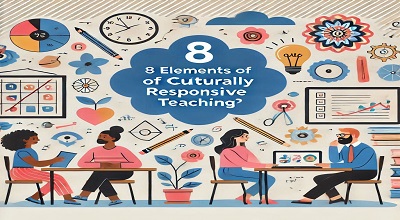8 Elements of Culturally Responsive Teaching
Today I am sharing What are the 8 Elements of Culturally Responsive Teaching? Culturally responsive teaching is an approach to instruction. That recognizes and values the cultural backgrounds of all students. And uses this awareness to make the instruction more meaningful for each learner². Different sources may have different ways of describing the elements of culturally responsive teaching. But one possible list of eight elements is:
- Positive perspectives on parents and families: Teachers communicate with and involve the families of their students in the learning process. And respect their cultural values and expectations.
- Communication of high expectations: Teachers convey to their students that they have high academic and behavioral standards for them. Provide them with the support and feedback they need to achieve them.
- Learning within the context of culture: Teachers use the students’ cultural experiences and knowledge. As a basis for instruction, and connect the curriculum to their lives and interests.
- Student-centered instruction: Teachers adopt a student-centered approach to teaching. Where they facilitate learning rather than dictate it and encourage students to collaborate, explore, and express their opinions.
- Culturally mediated instruction: Teachers use culturally appropriate instructional strategies and materials that reflect the diversity of their students. Such as multicultural texts, examples, analogies, and role models.
- Reshaping the curriculum: Teachers critically examine the curriculum and modify it to include diverse perspectives, voices, and histories. That is often marginalized or excluded from mainstream education.
- Teacher as facilitator: Teachers act as facilitators of learning rather than authorities of knowledge, and create a classroom environment. Where students feel comfortable sharing their ideas, questions, and concerns.
- Cultural competence: Teachers develop their own cultural awareness sensitivity, and respect. Appreciate the differences and similarities among their students.
What are some challenges of culturally responsive teaching?
Culturally responsive teaching is a way of teaching that respects and values the diversity of your students. Helps them connect the curriculum to their own cultures and experiences. However, it is not always easy or straightforward to implement this approach in the classroom. Some of the challenges that teachers may face when trying to adopt culturally responsive teaching are:
- Lack of knowledge or awareness of their own and their students’ cultural backgrounds, assumptions, biases, and perspectives. Teachers may need to engage in self-reflection and professional development to increase their cultural competence and sensitivity.
- Lack of appropriate or sufficient resources and materials that reflect the diversity of their students and the world. Teachers may need to search for, create, or modify curricula and instructional strategies that incorporate multicultural content and perspectives.
- Lack of support or collaboration from colleagues, administrators, families, or communities. Teachers may encounter resistance, misunderstanding, or indifference from others. Who does not share their vision or goals for culturally responsive teaching? Teachers may need to communicate effectively, build relationships, and seek allies who can support their efforts.
- Lack of time or flexibility to implement culturally responsive teaching in a meaningful way. Teachers may face constraints from standardized tests and curriculum mandates. Or other external factors that limit their ability to tailor their instruction to their student’s needs and interests. Teachers may need to find creative ways to balance the demands of the system and the needs of their students.
These are some of the challenges that teachers may face when trying to implement culturally responsive teaching in their classrooms. For more information and suggestions on how to overcome these challenges. You can check out the links provided in the web search results.
